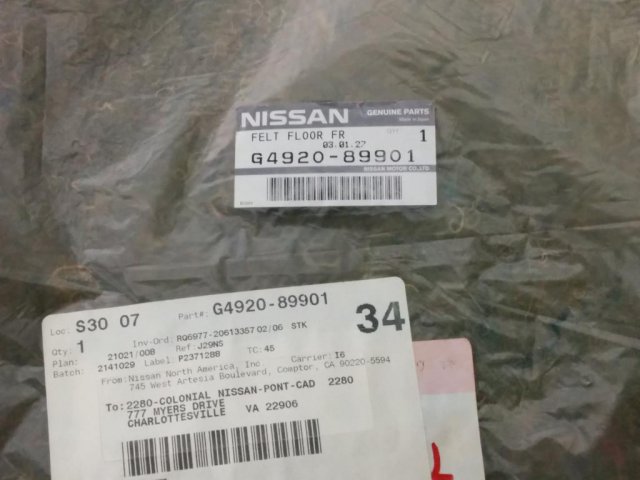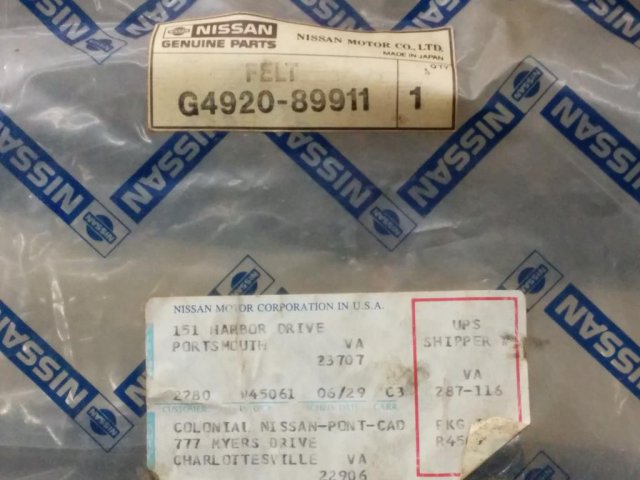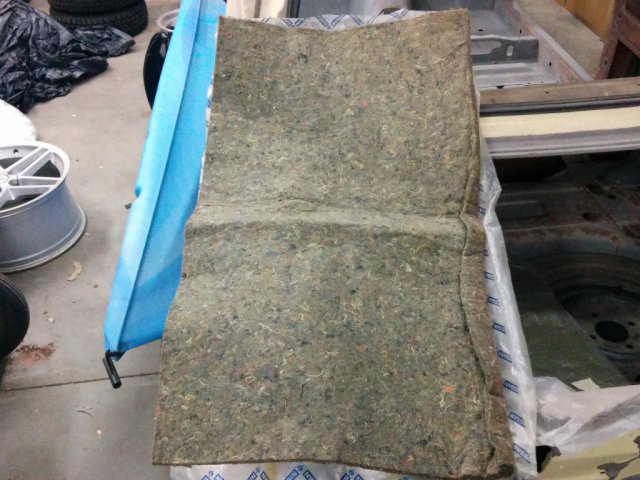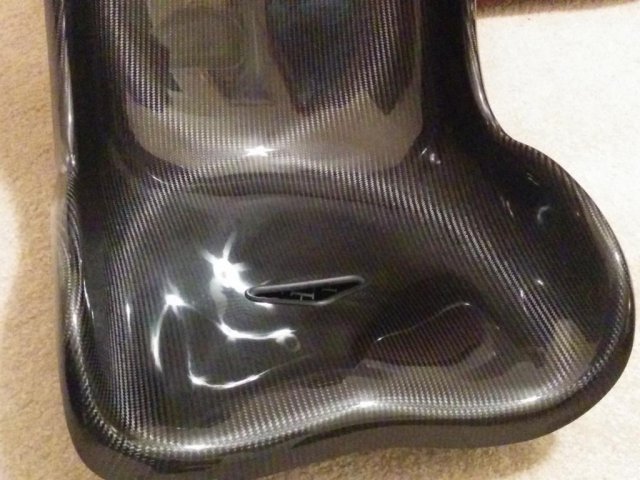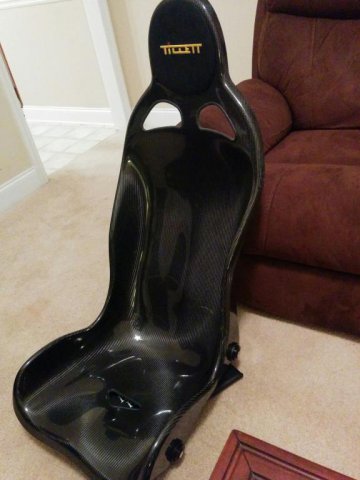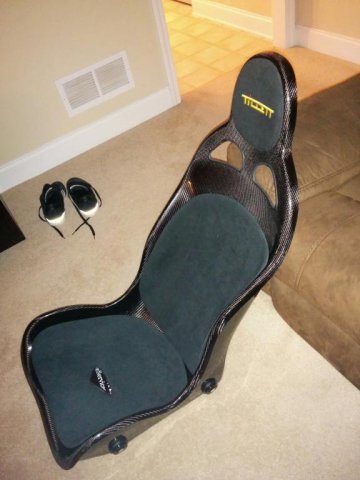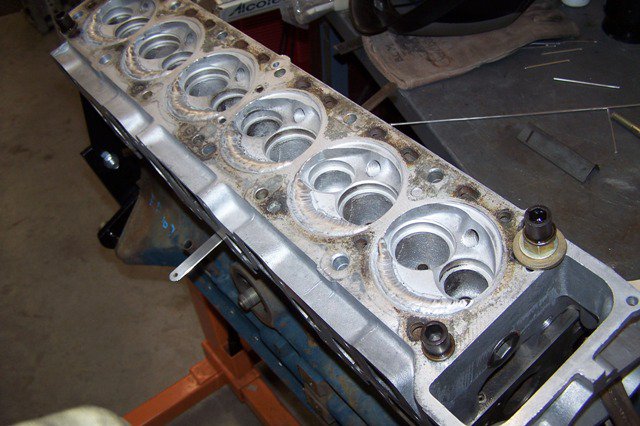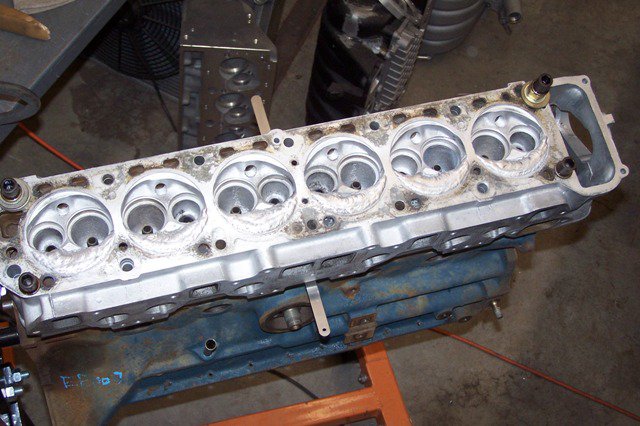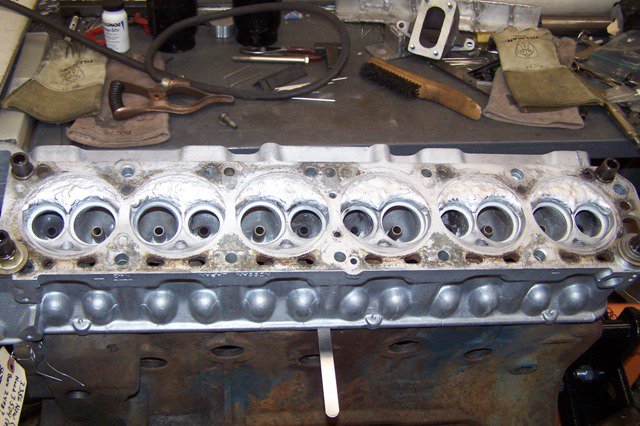-
Posts
464 -
Joined
-
Last visited
-
Days Won
3
Content Type
Profiles
Forums
Blogs
Events
Gallery
Downloads
Store
Everything posted by inline6
-
I just looked again at your pics. That is not a Z on the base of the needle. It is an N. That was followed by the number - most likely 27. Those are the right ones. You really don't want to have scarring at that point of the needle. You may want to polish them up with some 2000 grit sandpaper, or think about replacing them down the road. Also, when assembled can you lift the pistons to the roof with your fingers, hold them tight against the roof and let go of them both really quick... and see if the pistons drop both at the same rate, and if they clunk on the carb floors. They should drop at the same rate. And they both should clunk. If they don't you've likely got a bent needle which can keep the pistons from seating. That will cause a lean condition as well.
-
Honestly, until you confirm the cam timing, and the distributor drive are installed correctly, doing other things that rely on those to be right are half efforts. Even with the remanufactured distributor, you should get the markings on the casting so it can be properly identified. Assumptions, such as that they sold you the right reman distributor for example, don't help solve your problem. Facts are better. You need to do what I outlined in my last post. I became an expert with my 4 bolt SU carbs - I ran them for something like 15 years. There is a list of things that need to be done right for those to be right. However, quite a few things can be wrong on them, and they still work reasonably well. Just looking at the needles visually isn't going to help you identify them. New old stock ones I bought for my car came with black "ink" N27 printed on the fat part of the shaft that goes inside the piston. Easy to rub off... and once it is gone, no way to identify them by looking at them - you have to measure their diameter at specified intervals along the needles length and compare to notes others (search the internet) have made in that same regard. You can find that info online. The "Z" is probably just what a previous owner wrote on them with marker - no bearing on whether those are actually z car needles, or which z car needles, obviously. A lot of people don't know how to set the needles in the pistons right. And getting the needles in the correct position is a crucial thing about the Z's SU carburetors. To start, you have to wind the nozzles all the way in, have the domes off. Grab a piston and have the needle set screw loose enough to slide the needle in and out of the hole easily. Then put the needles in the pistons so the fat base portion sticks out easily an 1/8th of an inch. Next, set the set screw so it is just tight enough to keep so that the needles do not move on their own, but can move easily if pushed upon. Test this. The needles should move easily if you push or pull them in and out, but they should not move if you hold the piston vertically and shake it back and forth. Set the needle again so the base is proud of the piston bottom (both the channel and the bottom of the piston). Then set the pistons in the carb bodies making sure not to bump the needles as you align them to go into the nozzles. When you set the piston down all of the way, the ridge on the fat base of the needle will contact the nozzle - and the needle will be pushed up into the piston. This sets a "touching" or no gap fit between the shank of the needle and the nozzle top surface. Remove the piston carefully and tighten the needle set screw. When unscrew the nozzles to their initial settings per the manual, you will have the correct gap between the top of the nozzle and the base of the needle. The needles are now at the correct height. Other things: Don't bother with ATF in the piston tubes. Just use standard 10W30 motor oil. I tried ATF and it didn't work as well. There are low and high markings on the screw in "dip" sticks. Set them both to full when the sticks are threaded all the way in - don't go over. I used a small bottle (like air tool oil) which allowed me to add single drops of oil at at time - as necessary to get the level set precisely. If you don't have a carburetor synchronizer tool, buy one. You need to get the air coming into each carb to be the same amount. This is done at two places: at idle, and "off idle". Until you set this correctly - the front three and back three pistons will try to operate like two different engines. Obviously, not a good idea - not smooth. With these things and those of my prior post - if you do them and can supply specifics back, maybe the solution to your problem(s) won't be far off.
-
What distributor are you using (get the letters and numbers off of the casting)? You need this in order to know what initial timing should be as different distributors require different settings. Previous owner(s) could have changed it. You said you've set timing many times. What did you set it at - initial setting in BTDC (Before Top Dead Center) degrees? Have you watched the timing change as you rev it up? Are you able to see the timing advance working? There is supposed to be both a mechanical advance (accomplished with fly weight) and a vacuum advance. Confirm that when you rev the engine up from idle that the ignition timing changes... (it should increase). What is the total degrees it advances to by, let's say 3500 RPM? It should be at least in the 30 to 36 degree territory. I understand that there may not be marks going that high. However, you can estimate by adding some paint marks on your pulley based on the distance between the existing ones. Paint additional marks as necessary so you can see the total advance that is occurring. Have you checked that the cam timing is set properly? Take valve cover off (and spark plugs out) and rotate engine by hand/socket until a bright (or dark) link matches the mark on cam gear and then align cam gear to mark on front cam plate. Be aware that there are two links on the chain that are notably different from the rest, so you may have to do this for both of them. After many revolutions, you will see a marked link will line up with the mark on the cam gear. When you further align the cam gear with the mark on the cam plate, you should be able to look at the timing pointer and its relation to the crank pulley markings to verify cam timing is set right. If the pointer is not pointing at the TDC mark, then keep rotating until the next mark aligns with the cam gear mark - align cam gear with plate and check pointer at crank gear. If neither of these line everything up, your cam timing is off. Also, you should check that the distributor drive spindle is correctly installed - you can remove the distributor and view it compared to reference pics of where it is supposed to be at top dead center (look on this forum or google images). You need to know that all of the mechanical alignments are correct before you can conclude that your ignition timing setting efforts are being accurately performed. Until you knock these things out as possibilities for the problem(s), you have too many variables to troubleshoot systematically.
-

New Haven, CT area members - Need L6 block for dry sump project
inline6 replied to inline6's topic in Nissan L6 Forum
I am in Marietta, GA. I'm inquiring to see if anyone nearby to Moroso Performance Products would be able to help. Thanks for responding though. 2 hours away isn't going to be close enough. If they were 5 miles away from you, I'd try to get you to help! -

New Haven, CT area members - Need L6 block for dry sump project
inline6 replied to inline6's topic in Nissan L6 Forum
Maybe PM me the pricing you'd like to get for the block, and for delivery? That address is the correct one. I heard back from Moroso today, and they said the cost of the aluminum dry sump pan would probably run $700-$800. Not bad at all. -
I'm in contact with Moroso about making a custom dry sump oil pan. They want a block for fitment testing. Any members live nearby that could sell me a block? And, if I could pay you to drop it off, let me know. I realize this may be a far fetched request, but I thought I'd run it by hybridz'ers and see. I just need a junk block... L-24, L-26, or L-28, anything L in a six cylinder - doesn't matter which. Unless someone here can help, I'll have to source a block (maybe not so nearby) and have it shipped. I'll update this thread with another address if this one isn't where the block needs to go. If anyone else is interested in information about the dry sump pan, shoot me a pm. If there is interest, I'll set up a group buy thread. Moroso Performance Products 80 Carter Drive Guilford, CT 06437
-

Oil starvation ever an issue on L28 during racing?
inline6 replied to turbogrill's topic in Nissan L6 Forum
I ruined a race prepped motor at Road Atlanta (first track event for the engine) because a rod bearing and rod let go. I was running a Nissan Comp pan with something like 8 qt capacity. Member Clarkspeed posted that he has seen oil pressure drop at that track in my thread. Here is the relevant post from that thread. I am looking into having Moroso make a custom dry sump pan. Canton wasn't willing to make one. -
I've got a NOS P90A head. Take a look to confirm, but I am fairly certain it is identical to a P90 as long as you use the non-hydraulic rocker pivot towers. This video shows how to convert to non-hydraulic type. Let me know if you are interested.
-
Bryan will need to come up with a plan. My understanding is that the furnace brazing process heats the entire block to a specific temperature and that the brazing material, wherever it has been applied, will flow. We have discussed creating "stepped" liners. These would have machined steps where they seat in both the top and bottom decks. For the brazing, there is an ideal fit - the liners cannot be too tight or too loose. And of course the entire block will have to be remachined after the furnace...
-
Here is what I have: I had two complete, but I used one half of one of these. These are original nissan parts, but they may be a supercession of the original mats and not match 100%. My car never came with factory jute on the floors, so I don't know. Here is a link to a dealer: Let me know if you are interested in these.
-
I have an Electromotive Tec3r that I am planning to use. My plans are for a normally aspirated engine with a redline of 8000 to 8500. We'll have to see what the head will flow, but I'd like to see 400 hp. I am not well versed in fuel injection yet, but I think single injectors should be fine for my application. If we can find someone to do the block prep and furnace brazing work, I would think they would be more willing to do two than just one.
-
Lots of research and planning but not terribly far into the execution. I've settled on an N42 head which has had all of valve seats removed and it has had the chambers welded up. There is a lot more work to do on the head. We are working now to determine what to do for the valve train. We're wanting to go with valves with 7 mm stems and beehive springs. Right now, we're researching what spring retainers will work with the nissan keepers (collets). We're looking at machining the diameter down on some of the chrome-moly Schneider ones. We've got the LD28 block bored to 89 mm, but have to figure out how to proceed with liner design and have yet to source someone to make the liners and someone who can do the furnace brazing operation. We also plan to do Kolene® Kastech® Electrolytic to the block before brazing the liners into place. The next step Bryan will do is exploratory surgery on the bores of the LD28 to learn what we can about the bottom and top decks. I am not terribly concerned about pace of this project as we are building a 3.0 liter to replace the engine that was in the car for now. The head for that engine is only needing minor work. And the N42 block we are using for that engine has had all of the boring and other necessary machine work completed. I hope to have that engine in the car in March or April. Garrett
-
I believe I have some of the factory stuff... nos. Let me get a pic and get back to you.
-
A perfect fit for me - 5' 9.5" and 195 lb with 34 inch waist. Very comfortable - seems like they were probably made by creating some molds from form fitting foam. With L shaped mounting brackets, they weigh 9.2 lbs as best as my scale will measure. Seats by themselves are just under 7 lbs. I also got the fabric/fiberglass inserts you see in one pic and some sliders. More weight - but these aren't for a competition car.
-
We'll need to go bigger with the diesel block, yes. We didn't want the guy doing the boring to do more without Bryan (my engine builder) being there... and timing didn't work out right. The guy that did the boring took more than 8 months to get to it, so we were happy just to get this far. Bryan will do some manual cutting and examination to see exactly what we have to work with - the lower and upper decks. Liners will be custom designed, and may include a step, so we are wanting to move slowly rather than bore out another .120" and just go with what is left. The N42 will be run as is (after finish honing). After sonic testing, we offset bored three of the cylinders - (4, 5, and 6) .010" for wall thickness reasons leaving the minimal thickness (one spot in cylinder 4) at .170". It seems this N42 would be good for 90 mm... if .150" walls would be sufficient for normal aspiration. The N42 engine will be the temporary replacement in the car until the 3.5 L engine build has been completed.
-
Here are the bored blocks. N42 on the left, V07 on the right. The guy that did the boring said you could hear that the diesel block was thin while machining the bores. Both blocks were machined to 89 mm (actually about .004" under that). No break through to water on the diesel. Still looking for a place that can do the furnace brazing. Thought we got lucky with this place only about 30 minutes from Bryan, my engine builder, but they are shutting down and in the middle of moving the equipment to SC.
-
Finally got the LD block (V07 casting) bored to 89 mm. And, would you believe it didn't break through to water? Crazy I know. But it is obviously paper thin at this point. We'll be doing some more cutting on it to explore what we are dealing with. We're thinking brazing the liners in is the way to go now. So, looking for some assistance locating someone who can furnace braze the LD block. If you have leads, please send them my way. This is not a common thing these days.
-

NA 3.1L=>head & camshaft questions. No shortcuts, max
inline6 replied to zredbaron's topic in Nissan L6 Forum
Congrats Mark! A couple of questions: 1. Looks like all of your exhaust valves were hitting the pistons (looks like hitting them hard). Did you conclusively determine the cause? Was your timing chain off one tooth, like happened to me? Or, were the Ex. valves hitting the pistons for another reason? I have learned that the Sunbelt cam we are both using (the .565" gross lift one) was developed for use with titanium valves. My engine builder knows the guy that owned Integral Cams and worked on the development of our camshaft with Jim Thompson (formerly of Sunbelt). As you know, the AVG3E-L6SPR spring from Jim Wolf Technologies is the correct valve spring for use with the cam, and it has a very light (by comparison with most others) installed and max compressed loads. This spring is handling the additional weight of stainless steel valves, and chrome moly retainers if you are running those. Perhaps valves were floating and hitting the pistons? 2. What ever happened regarding the "reversion" area of the rpm band? Were you able to address it at all? When I was trying to do my dyno pulls (chassis dyno), the operator was telling me to go full throttle from 2k RPM in 4th gear and the engine simply wouldn't do that. It would just choke up and go dog rich. Same thing in third. How were you able to do "full range" RPM pulls to get your power charts, and do you have any of the AFR charts for those runs? 3. Are you running stock main cap bolts? My engine builder doesn't care for them. He says they are too big and don't stretch like they should to achieve proper fastening. 4. You are still running race fuel, right? 5. And I guess I missed it, but what was the most direct cause of the latest engine failure - debris sucked into chamber #1? Garrett -
Daylight between cylinders is proof positive that the block won't take an 89 mm bore. What is the engine number on the plate? Maybe we can get Speedtripper to tell us the number on his as well.
-
Yes. NZ is where I have been looking to source them. Any chance your sonic tests aren't accurate? And just so we are on the same page, 85 mm is the stock bore, correct? 3.5 mm and the requirement to run no less than .120" inch wall thickness means you couldn't bore that block more than about .010" inches? Just seems to fly in the face of logic that it could take so little.
-
I just heard back from someone that a sonic test on a V57 block showed 3.7 mm of wall on a stock bore. That's bad news for using a V57 block. You seem to have the only block that has taken a 89 mm bore!
-
Ok, it is time to start an engine build thread for my next engine. My last engine blew up spectacularly at Road Atlanta. Very disappointing. This one will be off the well beaten path, so there will be risks. So, here we go... Block work is stalled for now, but the N42 head is getting some attention. Per the Frank Honsowetz book, the cylinder head was bolted upside down on a block with a spacer to pre-load (bend) the head. The spacer used was 0.040". The welding is not done - this is just the start - welding rod was 40/43 I think. I will correct that if I find out differently. A few pics: Engine block will be a LD28, either a specially sourced V57 casting (one Hybrid Z member claims he has one that took an 89 mm bore and left 0.120" or more of cylinder wall), or a one off, custom liner design will be utilized. Garrett

